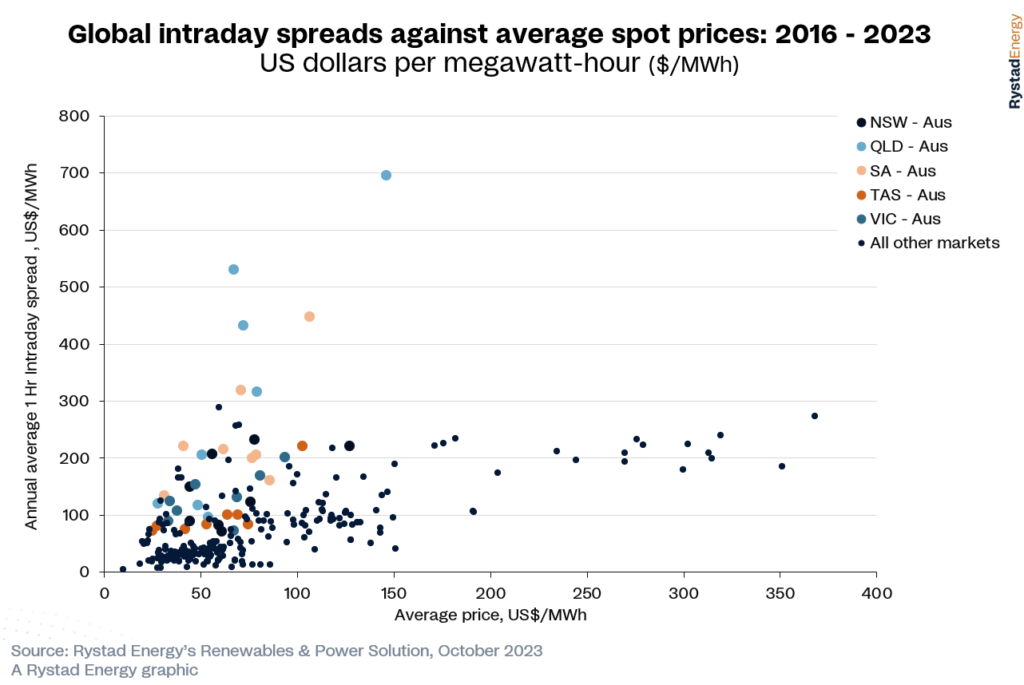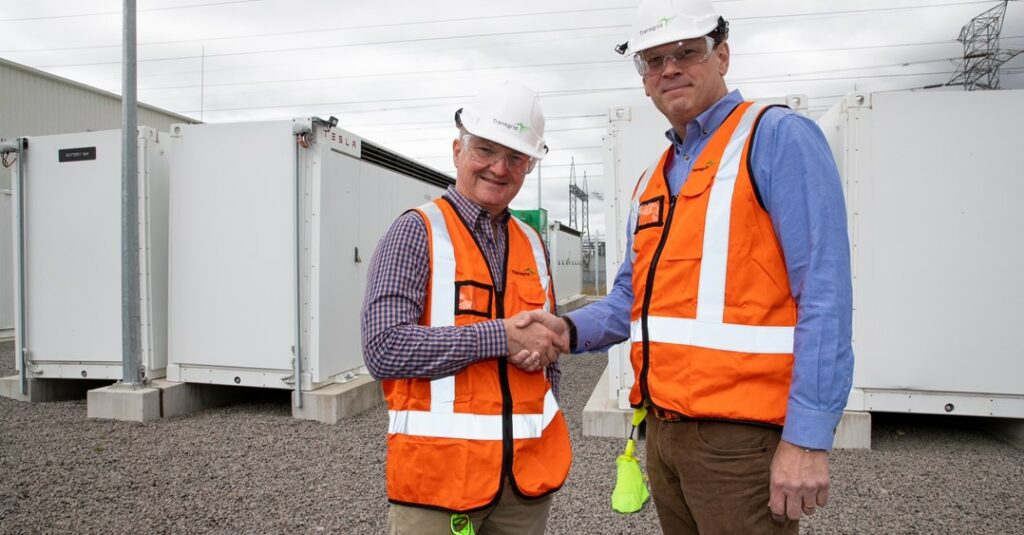
Australia’s National Electricity Market (NEM) has been handed the title of “most volatile electricity market” in the world, with an urgent need for energy storage to mitigate that volatility.
According to new research by Rystad Energy, the NEM experiences the highest amount of fluctuation in daily electricity prices out of 39 electricity markets globally, based on publicly available data. The next closest were markets in Japan and the Philippines, as well as what Rystad described as “select” regions of the US including California and Texas.
Enjoy 12 months of exclusive analysis
- Regular insight and analysis of the industry’s biggest developments
- In-depth interviews with the industry’s leading figures
- Annual digital subscription to the PV Tech Power journal
- Discounts on Solar Media’s portfolio of events, in-person and virtual
The NEM interconnects power markets in the Australian states of Victoria, Queensland, New South Wales (NSW), South Australia and Tasmania. Drivers of the volatility being seen are outages at coal power plants, the impacts of natural disasters on transmission infrastructure and the increasing penetration of variable renewable energy on the grid, mainly from solar PV.
For Rystad Energy’s analysis, volatility was measured as the difference between highest and lowest prices recorded for any given hour during the average one-hour intraday spread from data collected over a year.
The answers appear to be aligned with two of the main stated priorities of the Australian federal government when it comes to energy policy: built out and upgrade transmission networks, and deploy more energy storage – much more.
Rystad concluded that by 2050, balancing the NEM will require 46GW/640GWh of energy storage, which the research firm suggested would be provided by a combination of utility-scale battery energy storage system (BESS) assets and pumped hydro energy storage (PHES).
If anything, the Rystad forecast is perhaps on the conservative end of figures produced by Australian state organisations: the Australian Energy Market Operator (AEMO) has identified a need for between 44-96GW output and 550-950GWh energy storage capacity in the NEM by the middle of this century.
Similarly, national science agency CSIRO has said that storage capacity in the NEM needs to increase somewhere around ten to 14 times over in the years 2025-2030 to be set up to meet the 2050 net zero emissions target.
Currently, there are about 2.5GW of utility-scale batteries and pumped hydro participating in the NEM, according to Rystad Energy analyst David Dixon.
Furthermore, the AEMO said earlier this year that there is an urgent need for long-duration energy storage (LDES) to balance the NEM, noting for example that while it took in applications for 461MW of BESS projects between August 2022 and February 2023, this only corresponded to 604MWh of capacity – meaning that few projects were of durations above 2-hours and certainly almost none of 8-hour or above.
Incidentally, AEMO, which is overseer of the NEM as well as Western Australia’s Wholesale Electricity Market, found that Western Australia alone needs 12GW-17GW/74GW/96GWh of storage in its market by 2050.
“Volatility can be unsettling for retailers who lack proper hedging strategies and for consumers who bear the brunt of resulting cost fluctuations,” Rystad Energy’s David Dixon, a senior analyst, said.
“To tackle this, Australia should prioritise the enhancement of transmission infrastructure and invest in storage solutions to mitigate the impact of volatility. This will help to create a more stable and affordable electricity market for all Australians.”
Government tenders can unlock Australia’s required investment
While reliability is sometimes cited as a reason for maintaining reliance on fossil fuel plants, it is largely due to unplanned outages at coal power plants that resulted in much of the volatility cited by Rystad.
Clean energy transition expert Stephanie Bashir of Nexa Advisory told Energy-Storage.news that Australia’s ageing coal power plants are becoming “more unreliable”.
Meanwhile, the country has an “unrivalled opportunity to be powered by renewable energy,” due to its geography and climate, Bashir, Nexa Advisory’s CEO, said.
The reasons why growing shares of solar PV meanwhile contribute to volatility is due to what happens both in the daytime and at night: during daytime hours, high production of solar-generated electricity depresses prices in the NEM, but at night, presently natural gas plants are used to fill in the gap left by the solar, driving prices up.

Australia’ coal plants are also retiring, and government statistics show that from contributing 84% of electricity generation at the beginning of the millennium, it fell to below half (47%) in 2022. Meanwhile, renewables comprised 32% in 2022, and there was 25% growth in solar PV capacity. Utility-scale solar PV generation grew 29% from 2021 to 2022, and by 78% over five years as of the end of 2022.
“To ensure that Australians have the secure, reliable and affordable power they need, and deserve, we need to ensure proper ‘firming’ of these renewable technologies is considered,” Stephanie Bashir told Energy-Storage.news.
Australia’s energy storage sector is definitely on the up, with nearly twice as much battery storage being built during 2022 as in the previous year, from 921MW/1,169MWh being built during 2021, to 1380MW/2,004MWh last year.
However, that still seems far off from getting to the levels Rystad, AEMO and CSIRO have all recommended will be required. The good news, Stephanie Bashir said, is that the Capacity Investment Mechanism – a scheme of tenders and auctions for dispatchable renewable energy capacity with mandatory inclusion of energy storage – is on the way.
Launched at federal level, but set to be administered by the individual states, the Capacity Investment scheme has been described by Australia’s energy minister Chris Bowen as a sort of de facto energy storage target or national energy storage strategy of the type many clean energy advocates were angling for.
It would provide investors with some degree of revenue certainty and has been warmly welcomed by many sources Energy-Storage.news has spoken to, including Nexa Advisory’s Stephanie Bashir.
“At present the market structures and price volatility are enhancing risks for consumers and investors. We see the federal government’s Capacity Investment Scheme playing a critical role in providing the certainty needed to unlock investment in the battery storage sector,” Bashir said.






